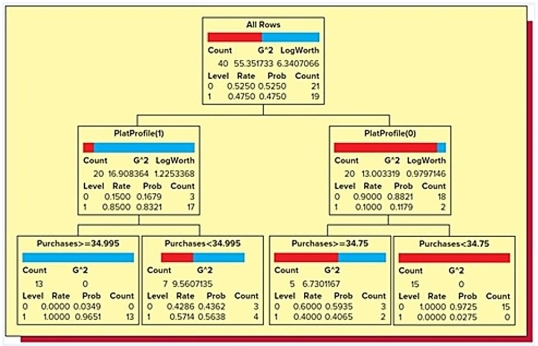Suppose that a bank wishes to predict whether or not an existing holder of its Silver credit card will upgrade, for an annual fee, to its Platinum credit card. To do this, the bank carries out a pilot study that randomly selects 40 of its existing Silver card holders and offers each Silver card holder an upgrade to its Platinum card. Here, the response variable Upgrade equals 1 if the Silver card holder decided to upgrade and 0 otherwise. Moreover, the predictor variable Purchases is last year's purchases (in thousands of dollars) by the Silver card holder, and the predictor variable PlatProfile equals 1 if the Silver card holder conforms to the bank's Platinum profile and 0 otherwise. Below is the classification tree they derived from the data collected in the study.  Assume they classify those with an upgrade probability estimate of at least .5 as upgraders. Based on this classification tree, a member of the study sample who made $50,450 in purchases last year, did not conform to the bank's Platinum profile, and upgraded to the Platinum card would be…
Assume they classify those with an upgrade probability estimate of at least .5 as upgraders. Based on this classification tree, a member of the study sample who made $50,450 in purchases last year, did not conform to the bank's Platinum profile, and upgraded to the Platinum card would be…
Definitions:
Hydrogen Cycle
The biogeochemical cycle of hydrogen, which involves the movement and exchange of hydrogen atoms between the biosphere, lithosphere, atmosphere, and hydrosphere.
Phosphorus Cycle
A biogeochemical cycle that describes the movement of phosphorus through the lithosphere, hydrosphere, and biosphere.
Ecological Efficiency
The efficiency with which energy is transferred from one trophic level to the next in a food chain.
Trophic Level
The position that an organism occupies in a food chain, defined by how it gains its energy, usually ranging from producers to apex predators.
Q25: An internet service provider (ISP) has randomly
Q36: Joe is considering pursuing an MBA degree.
Q39: Dividing the entire data set into a
Q46: In a study of employee stock ownership
Q62: The proportion of measurements in a class
Q72: The exponential probability distribution is based on
Q84: In a manufacturing process, a machine produces
Q98: The k-nearest neighbors approach can be used
Q106: The following is a partial relative frequency
Q150: If the random variable, X, is normally